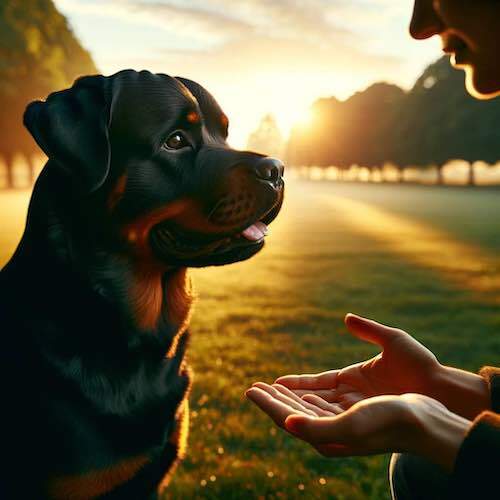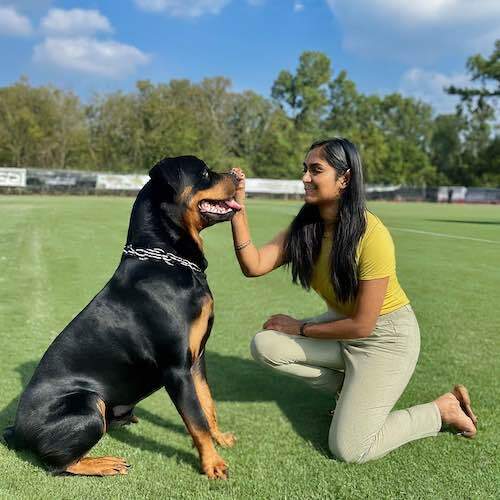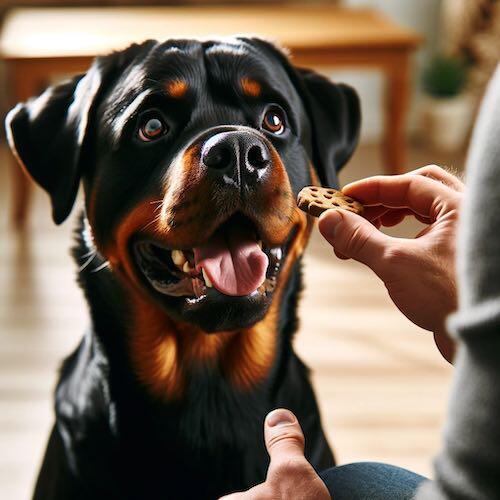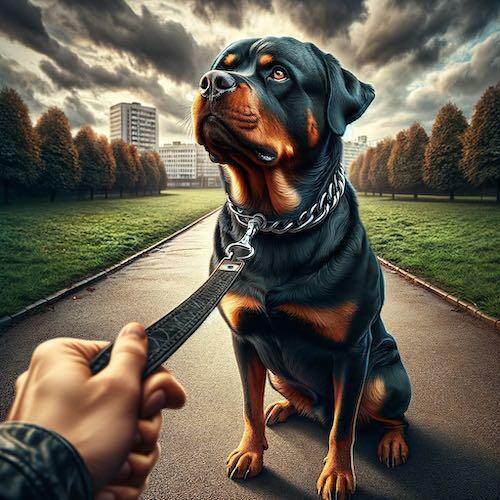Training your Rottweiler isn’t just about teaching tricks; it’s an essential building block for a fulfilling life together. Proper training unlocks your Rottweiler’s potential, transforming them into a beloved family member and a confident ambassador for the breed.
Here’s why Rottweiler training holds incredible importance: it creates a safer environment for your dog and those around them, enhances their mental well-being by providing structure and mental stimulation, strengthens your bond through positive interactions, and promotes responsible ownership – allowing your Rottweiler to truly thrive while combating breed stereotypes.
Search Best Rottweiler Products for 2024
Rottweiler Training 101: The Ultimate Guide
Introduction: Misconceptions & Responsible Ownership
Rottweilers: Beyond the Stereotypes
Rottweilers, with their blocky features and powerful frames, are undeniably impressive dogs. Unfortunately, media depictions often perpetuate harmful stereotypes, portraying them solely as snarling, uncontrollable guard dogs. The truth, however, paints a far richer and more complex picture. While capable protectors, well-raised and understood Rottweilers are gentle giants at heart, fiercely loyal, eager to please, and bursting with playful intelligence.
Responsible Ownership: The Cornerstone of a Thriving Rottweiler
Choosing to share your life with a Rottweiler isn’t a light decision. Responsible ownership lays the foundation for both you and your canine companion to not only survive but truly thrive. It involves crucial components:
-
Commitment: Embracing the Long Haul Training and guidance for your Rottweiler shouldn’t be a fleeting project. It’s a cornerstone of your relationship, evolving as your dog does. Think of it as a marathon, not a sprint. Consistency in rules, expectations, and training solidifies a true partnership.
-
Research: Knowledge is Power Dedicating time to understand the breed’s unique history, drives, and potential challenges is non-negotiable. This isn’t simply a general-purpose dog – responsible ownership includes tailoring your approach to the Rottweiler temperament. Seek out reputable books, breed-specific resources, and the advice of ethical breeders and trainers for insights beyond common assumptions.
-
Realism: An Honest Self-Assessment Rottweilers are remarkable, but not universally suitable for every home. Evaluate your lifestyle honestly. Do you have the physical ability to handle a large, muscular dog on walks and in daily life? Can you dedicate time each day for exercise, training, and mental enrichment? Are you confident managing guarding instincts and protective tendencies?
-
Advocacy: Beyond Your Own Home Owning a Rottweiler extends beyond your immediate relationship. Your well-trained, confident Rottweiler companion stands as a powerful ambassador for the breed. Be prepared to counter those misguided stereotypes by showcasing the intelligence, trainability, and loyalty true to the breed’s potential. Your efforts will positively resonate beyond just your own furry friend.
Additional Considerations
- Early Intervention: Don’t wait for problems to emerge. Proactive training from a young age, emphasizing socialization and positive reinforcement, helps prevent issues down the line.
- Spay/Neuter: While not directly part of training, responsible ownership often includes these procedures which impact behavior, especially roaming and potential aggression. Discuss this with your veterinarian.
- Adaptability: Despite their size and strength, Rottweilers can adapt to a range of situations. However, ample exercise, engagement, and proper training remain essential whether you live in a suburban home or an apartment.
Remember, the ‘dangerous Rottweiler’ often portrayed stems not from the breed itself, but from lapses in responsible ownership fueled by lack of knowledge or unrealistic expectations. Embracing this commitment to training, understanding, and providing an appropriate environment creates an environment where the magnificent Rottweiler truly shines.
The Rottweiler Mind: Intelligence, Temperament, and Needs
Understanding what makes your Rottweiler tick is crucial for training success. A look at their heritage helps understand their inherent drives and desires, allowing you to channel them in positive ways. Here’s an in-depth breakdown of their traits:
-
Work Ethic: Historically, Rottweilers were working dogs – drovers, protectors, and companions. This tireless breed wasn’t bred to be a couch potato! They need both physical and mental stimulation to truly thrive. A bored Rottweiler can become destructive or develop unwanted behaviors.
-
Intelligence: Rottweilers are smart – a highly trainable breed. They are eager to please their owner, which makes them fantastic candidates for learning and mastering a variety of skills. However, that very intelligence means they can sometimes try to outsmart you! Being one step ahead with consistent training is important.
-
Potential Stubbornness: It’s part of the package! A Rottweiler may occasionally decide to test limits and boundaries. They require unwavering leadership and confident handling that is firm but never harsh. Don’t get discouraged – clear expectations and unwavering consistency will pay off significantly.
-
Guard Instincts: They’re naturally protective of their family and territory. A watchful spirit makes them good potential protectors, but it also highlights the importance of two things: 1) early socialization to prevent overly fearful or aggressive responses, and 2) training for controlled guarding behaviors that you have a handle on. They should be your loyal protector, not an unpredictable terror.
Additional Notes:
- Adaptability: While a dedicated breed, Rottweilers can adapt well to a variety of environments provided their need for activity and companionship is met. They aren’t meant to be backyard-only dogs.
- Sensitivity: Their seemingly tough exterior belies a sensitive side. Rottweilers generally don’t respond well to harsh training methods or angry outbursts. They’ll perform best under your guidance, forged through positive relationships.
Puppyhood to Adulthood: Stages & Training Adaptations
Your Rottweiler training approach isn’t one-size-fits-all. As your companion grows and matures, be prepared to shift your techniques accordingly for optimal results. Here’s a breakdown of the major stages:
-
Puppyhood (8-16 weeks): The Golden Opportunity This is a crucial time for your Rottie’s development. Prioritize:
- Socialization: Early, controlled exposure to various people, dogs, sights, and sounds lays the foundation for a confident, adaptable adult. Make these outings positive and safe to prevent undue fearfulness.
- Foundation Training: Start with the basics! Sit, down, come, and stay become building blocks for more complex skills. Keep those puppy attention spans in mind – short, playful sessions win the day.
- Potty Training: Consistency is everything. Regular potty breaks based on their age, supervision, and tons of praise for eliminating outside will have your pup housebroken before you know it.
- Positive Reinforcement: This breed thrives on rewards – make treats, toys, and verbal praise your superpowers. Show them that the right behavior brings good things!
-
Adolescence (6-18 months) Expect the Unexpected: Just like with human teenagers, hormones surge and a “rebellious” streak may emerge.
- Boundaries & Consistency are Key: They might suddenly forget those potty manners or challenge your established rules. Stay firm and don’t waver – mixed messages will only confuse and prolong this phase.
- Exercise is Life: That youthful Rottweiler energy is explosive! Insufficient outlets for exercise can lead to destructive behaviors, boredom, and unwanted barking. Long walks, play sessions, and engaging in mentally stimulating activities will keep everyone sane.
- Training Maintenance: Continue to reinforce those core commands they learned as a puppy. Don’t allow them to slack!
-
Adulthood: Continued Growth & Refinement Your Rottweiler may settle down a bit, but the learning continues! At this stage, focus on:
- Advanced Obedience: Commands like “leave it,” “drop it,” “place,” and even off-leash reliability add polish, convenience, and safety to your lives together.
- Social Refinement: Life throws curveballs! Continue providing positive encounters with various situations, people, and other animals to keep them adaptable and calm in different environments.
- Finding Their Fun: Rottweilers often excel in obedience, agility, scent work, or even protection training (which should always be approached with a qualified professional). Discover what ignites their enthusiasm!
Important Notes:
-
Flexibility: Each Rottweiler develops at their own pace. Keep these milestones as a general guide, adjusting as needed for your dog’s specific personality and learning rate.
-
Professional Support: If you encounter challenges beyond your ability or comfort zone at any stage, don’t hesitate to enlist the help of a certified dog trainer using positive, science-based training methods. An outside perspective is often invaluable, especially with powerful breeds.
Foundation: Socialization, Housetraining, & Crate Training
Socialization: Shaping a Confident, Adaptable Rottweiler
Early, thoughtful socialization is paramount for Rottweilers and truly every puppy. It’s about instilling in your companion a confidence in various situations, preventing undue reactions from fear or overexcitement. Key points for success:
- The Window of Opportunity: Puppies go through critical socialization periods, and starting right when they come home is ideal. Aim for controlled, positive exposures before anxieties have time to form.
- Variety is Key: Expose your Rottie pup to people of various ages, appearances, and genders. Seek encounters with calm, well-mannered dogs. Introduce novel sights (bikes, strollers), sounds (traffic, household noises), and textures (walking on different surfaces).
- Slow and Steady: Don’t overwhelm! Brief, upbeat interactions are essential. Observe your puppy’s reaction; pushing too far can backfire. Let their curiosity lead, rewarding comfort and engagement with the world.
- Safety First: Ensure all introductions are controlled to prevent frightening your young Rottweiler. Unvaccinated puppies need special measures like interacting with healthy, known dogs at home until cleared by your vet.
Housetraining: Patience, Routine, and Rewards
Laying a housetraining foundation sets both you and your pup up for success. Here’s how to master this milestone:
- The Power of Routine: Puppies have limited bladder control. A consistent schedule for potty breaks is your best friend! Based on age (e.g., every 2-3 hours), and after playing, eating, or napping, take them to their designated potty area.
- Supervision is Key: Confine to puppy-proofed areas when you can’t keep a close eye. This allows you to observe pre-potty signals like sniffing and circling, enabling swift trips outside.
- Celebration in Order: Don’t be shy with praise when they eliminate in the right spot! Treats, happy voices, and play make them more eager to repeat the desired behavior.
- Accidents Happen: Clean messes thoroughly with an enzymatic cleaner to remove the urine scent that encourages repeat offenses. Remain patient and avoid punishment – consistency is ultimately what teaches them where to go.
Crate Training: Their Den, Your Peace of Mind
Done properly, crate training offers multiple benefits for you and your Rottweiler. Here’s how to maximize its potential:
- Cozy & Inviting: Make the crate a haven, not a punishment zone. Start with short periods inside with comfortable bedding, special toys, open door accessibility, and lots of treats for simply entering. Feed meals in there with the door open.
- Closing the Door: Begin gradually building up duration with the door closed while you’re nearby. Ignore brief complaints (they’ll learn that fussing doesn’t achieve instant release) and lavish with praise upon quiet exits.
- Expanding the Role: Use crate time for brief periods of unsupervised relaxation, to prevent potential destructive behaviors out of boredom. It’s also a valuable tool to aid in potty training, giving them a designated “space” they are less likely to soil.
- Age Appropriate: Never utilize the crate for excessive hours beyond a puppy’s ability to hold their bladder – this sets them up to fail. The crate helps build routine, not eliminate the need for frequent potty breaks.
Essential Commands: The Non-Negotiables
Sit: The Gateway Command
“Sit” is the starting point for so much more! Here’s why it’s so valuable and how to achieve it:
- The Benefits of Sit: It’s a polite default position making greetings, vet visits, and grooming safer and more manageable. “Sit” can also interrupt jumping tendencies and offer an alternative, desired behavior rather than simply saying “no”.
- Methods to Teach:
- Lure Method: Hold a treat slightly up and back over your Rottie’s head. Their natural impulse to follow will generally result in a “sit.” The moment their bottom hits the floor, say “sit”, deliver the treat, and lavishly praise.
- Hand Guidance: With treats and your dog standing in front of you, give the “sit” command. Then with one hand under their bottom, gently guide them into a sit while delivering the cue. This can assist pups who can’t seem to quite “get” the lure method on their own.
Stay: Cultivating Patience and Impulse Control
“Stay” forms the foundation for safe waiting and impulse control around tantalizing situations:
- Start Small, Grow Big: At first, “stay” is about mere seconds of your pup staying put before receiving a release word like “Okay!” and their reward. Gradually, you build this up from short duration to longer periods.
- Distance & Distraction: Practice the “stay” initially close to you. You’ll slowly begin adding elements of distance (while always staying in their eye line), and later, increasing distractions while they maintain their focused waiting.
- Teaching Technique: Have your Rottie “sit” first. Then, offer a “flat palm signal” to signal staying in place, saying “stay.” Back away (initially just a step), make short eye contact, then return (release with “Okay!”), praise, and treat. Repetition builds their understanding.
Down: Calm Excitement, Aid Grooming
“Down” positions help you to regain control when your Rottie is overexcited and offers more ease with grooming situations:
- Methods to Teach:
- Lure Method: Start with your pup in a standing position, place a treat at nose level and gradually lure it down toward the floor between their front legs. Their body is likely to follow suit. As soon as they lie down, utter the cue “down,” deliver the reward, and lavish that praise.
- Hand Shaping: Start with your dog in a “sit”. Holding a treat, touch the ground close to their body. As they move closer to investigate, continue moving your hand slightly further out away from them. This gradual motion often results in them following by lying down. Say “down” upon completion for connection, followed by reward and praise.
Come: A Potentially Lifesaving Command
A reliable recall (“come”) is your pup’s safety net – ensuring they return to you even in highly exciting or frightening situations:
- Make it a Party: “Come” needs to be associated with the best things in life! A high-pitched enthusiastic voice, loads of praise, extra special treats, and even a brief game upon reaching you – make a beeline to you absolutely thrilling.
- Start Easy, Get Harder: At first, practice indoors or in low-distraction areas. Gradually add distance and distractions as the skill solidifies.
- Never Punish: Don’t scold your Rottie when they finally reach you – even if it took longer than desired. This makes them LESS likely to want to come in the future!
Heel: Loose-Leash Walking Bliss
A “heel” positions your dog next to your leg. This builds on loose-leash walking by adding structure and precision:
- Patience is a Virtue: “Heel” takes time and practice – don’t rush! Rewarding your Rottie frequently for walking calmly at your side lays the foundation for adding a verbal cue later.
- Side Matters: Choose what leg your Rottie will heel on and be consistent.
- Short Practice: Train initially for brief intervals during your walks, and slowly increase length.
These essential commands open a world of training possibilities. Remember, frequent sessions, patience, and a hefty dose of enthusiasm will transform those core commands into reliable behaviors, showcasing your well-mannered Rottweiler with pride!
Leash Manners: Creating Relaxed Walks
The ‘Pulling Problem’ Deconstructed
Before applying training techniques, remember why your Rottweiler pulls: it works! If yanking gets them where they want (to greet that bush, chase a squirrel, etc.), that behavior will continue. You want them to understand that a loose leash equals progress and fun, while a tight one results in going absolutely nowhere.
Gear Matters: Finding the Right Tools
- Harness or Head Halter: These tools can add comfort and additional control during training. Front-clip harnesses and head halters can provide leverage to help redirect a powerful Rottie. However, avoid choke chains or prong collars; these use pain and can create behavioral fallout, potentially damaging your bond.
- The Leash: A standard 4-6 feet fixed-length leash offers the control needed for training. Avoid extendable leashes; they create inconsistent tension and train your dog to always walk out to their full length.
Techniques for Success
- Change Direction: The Power of 180s The moment that leash tautens, perform an abrupt about-face and start walking confidently in the opposite direction. Your Rottie will become disoriented and learn to pay close attention to your direction to find themselves suddenly going off course.
- Stop and Go: Master the Statue Walk If your dog tries to drag you, become a tree – plant your feet and remain still. Don’t engage in a pulling tug-o-war! The second the leash loosens, even slightly, reward and start walking again. Repeat with unwavering consistency.
- Rewards Galore Walking calmly by your side deserves celebration! Frequently deliver high-value treats (consider boiled chicken or other favorites) and lavish verbal praise throughout walks to make being close to you the absolute best place on earth.
- Training Sessions vs. Regular Walks Initially, implement leash training during dedicated training sessions in less stimulating environments. Once your Rottie masters a loose leash here, begin extending this into full walks with increased distractions.
Additional Tips
- Manage Expectations: It may take time and consistency, especially with an adult Rottweiler with an established habit. Don’t despair – even small improvements deserve praise!
- Tire Them Out: A Rottie drained of excess energy before walks may have less pent-up excitement to release as pulling. This doesn’t substitute training, but creates a better mindset for focus.
- “Premack Principle”: Couple loose leash walking with rewards your dog truly values. Let them briefly greet that friendly dog or sniff that enticing bush ONLY after offering a few steps at a calm pace by your side.
When to Seek Help
If pulling persists despite dedicated training, is combined with barking or lunging reactivity, or you simply feel overwhelmed, reach out to a qualified dog trainer specializing in positive reinforcement. Sometimes personalized help and the objective eye of a professional can offer invaluable breakthroughs.
Beyond the Basics: Obedience, Behavior Modification, & Activities
Advanced Obedience: Taking Control to the Next Level
-
“Leave It”: The Power of Impulse Control This highly valuable command can save lives. “Leave it” teaches your Rottweiler to disengage from potentially dangerous objects (dropped food, animal carcasses), and ignore distractions. This can begin with low-level temptations, such as a treat on the floor, gradually scaling up to enticing moving distractions. Practice is essential to instill this reliable impulse control.
-
“Drop It”: Safety & Cooperation Imagine the chaos of your Rottweiler nabbing something they shouldn’t have! “Drop it” trains them to relinquish objects on cue, whether stolen laundry or potentially harmful items. Initially, utilize low-value items for a fun exchange process – give the “drop it” command, offer a high-value treat in exchange, and lavish praise upon release.
-
Off-Leash Reliability: Control Unleashed Mastering off-leash recall brings an exhilarating freedom for both you and your Rottie in appropriate safe zones. It demands strong obedience foundations (“come”, “sit”, “stay”) and a long line for training in less secure environments. Starting in low-stimulus settings, focus heavily on rewarding returns to you, establishing a “check-in” habit (brief eye contact/reward), and building that rock-solid bond that prioritizes you over ANY distraction.
Behavior Modification: Tackling Behavioral Challenges
Even the best-trained Rottweiler sometimes displays concerning behaviors. Don’t ignore problems – early intervention is vital for ensuring the safety and well-being of your dog and those around them. Here’s what to know:
-
Common Concerns:
- Aggression: Can stem from fear, territorial instincts, or resource guarding. Requires targeted assessment and intervention to prevent escalation.
- Reactivity: Lunging, barking, overly heightened reactions to perceived threats. Modifying reactivity takes focused desensitization, counter-conditioning, and management techniques.
- Resource Guarding: Possessiveness over food, toys, or even people. Careful, targeted approach necessary to prevent escalation into bites.
-
When to Seek Professional Help: If facing concerns beyond “typical puppy silliness,” never hesitate to reach out to a certified dog trainer specializing in positive reinforcement, or a board-certified veterinary behaviorist (DACVB). These professionals, knowledgeable in dog body language, behavioral science, and modification techniques can address problem behaviors effectively, ensuring everyone’s safety and improving your bond with your Rottie.
Activities: Finding Your Rottweiler’s Inner Champion
A bored Rottweiler is a recipe for trouble. Help your companion shine by discovering engaging, fulfilling activities:
- Obedience & Rally: Showcase precision and your team’s bond through competition courses and advanced commands.
- Agility: A thrilling sport, highlighting a Rottweiler’s athleticism, training, and responsiveness.
- Tracking & Scent Work: Tap into their natural drive with nose-based work, perfect for mental stimulation and fun.
- Protection Sports: Specialized, advanced training focusing on controlled protection situations like Schutzhund. Important: This work requires experienced hands and a thorough understanding of the Rottweiler temperament for its safe and appropriate execution. Always seek the guidance of certified, reputable trainers who specialize in this sport.
Important to Remember: Every Rottweiler is a unique individual. Explore various activities to find where your dog thrives. Observing their enthusiasm and progress reveals their hidden talents! Participation in appropriate activities not only brings fun and challenges, but also deepens your connection with your beloved companion.
Finding the Right Support: Trainers, Behaviorists, & Resources
The Power of Professionals: Certified Positive-Reinforcement Trainers
Whether a seasoned dog owner or a Rottweiler beginner, a professional trainer who embraces positive reinforcement can be an invaluable ally on your training journey. Here’s why:
-
New Owner’s Friend: First-time Rottweiler owners benefit immensely. An experienced trainer helps establish solid foundations, preventing unintentional reinforcement of bad habits. It’s the “ounce of prevention” approach and provides valuable breed-specific insights.
-
Specialized Challenges: From puppyhood struggles to behavioral concerns, professionals offer a helping hand. Utilizing dog behavior science and ethical training techniques, they address the root cause of problems rather than masking symptoms.
-
Tailored Guidance: No one dog fits neatly into a YouTube tutorial. Expert trainers assess your specific situation, your Rottie’s personality, and your goals, then create a training plan that works within your lifestyle and capabilities.
-
Training You Too!: Trainers impart skills alongside commands. Understanding behavior, canine body language, and timing of reward/correction empowers you long after training sessions end. It’s not just about your dog learning, but about growing together!
Finding the Right Fit: What to Look For
- Certifications: Seek trainers with certifications from reputable organizations focused on positive training methodologies – the most widely respected being CPDT-KA. Look for titles like “Certified Professional Dog Trainer – Knowledge Assessed.”
- Breed Experience: While not absolutely essential, choosing a trainer who understands Rottweiler drives, history, and temperament provides extra advantages in tailored training approaches.
- Your Connection Matters: Schedule consultations before commitment. You should feel comfortable, enjoy their teaching style, and agree with their philosophy. This personal connection impacts results!
Beyond Trainers: Expanding Your Learning Toolkit
While trainers are vital assets, continue supplementing your knowledge with other reliable sources:
- Reputability Rules: Avoid sources promoting dominance, fear, or pain. Outdated “Alpha” concepts harm, not help, your relationship with your Rottie. Focus on positive reinforcement based resources.
- Authors & Experts: Seek books by authors with reputable certifications in the dog training field – authors like Sophia Ying, Patricia McConnell, and Jean Donaldson offer reliable information.
- Breed Experts: Online breed-specific forums and organizations hold a wealth of Rottweiler knowledge, but maintain critical judgement; not all “experienced owners” truly understand effective training principles.
- Verified Research: Websites like PubMed offer science-based behavior studies. Learning these fundamentals allows you to assess if suggested techniques truly align with best practices.
- This Guide Is a Beginning This very guide can evolve based on your needs! Growing our resources along with your Rottie’s skills keeps both your minds engaged.
Remember, training shouldn’t feel isolating. Lean on reputable trainers for initial guidance and deeper problem solving. Then, expand your knowledge through verified materials, allowing you to confidently adapt to your Rottweiler’s progress. This supportive approach ensures success not just in the moment, but throughout your dog’s life.





